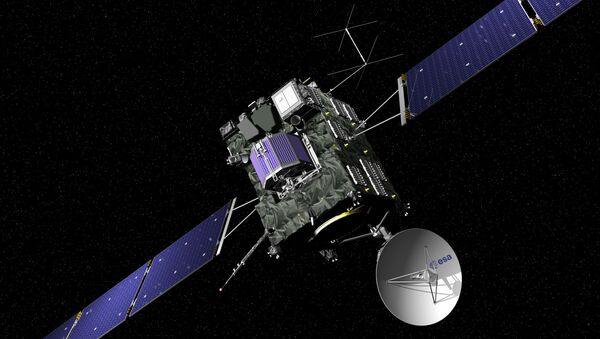MOSCOW, November 3 (RIA Novosti), Ekaterina Blinova — Within a few days, the European Space Agency's Rosetta spacecraft will drop a tiny lander called Philae onto the surface of a mysterious comet, 67P/Churyumov–Gerasimenko: a huge chunk of ice and organic chemicals that has been travelling for billions of years through outer space.
"Rosetta and the Philae lander should answer two of the most important questions in science: where did Earth's water come from; and – ditto – the carbon atoms that make up living things?" the Independent reported.
Due to the fact that comets are "leftovers" from the era of our solar system’s birth, a thorough examination of 67P/Churyumov–Gerasimenko’s composition may help scientists solve numerous questions regarding the Earth's formation and the origin of life.
"This all creates a scientifically enormously interesting mixture, [which can be used] in order to study the origin of the material of our solar system, the formation of our Earth and the origin of life," Professor Kathrin Altwegg of the University of Bern’s Center for Space and Habitability (CSH) noted, as quoted by the Swiss university's official media release.
Rosetta has been taking measurements of the comet since August 2014 and has already detected "some pretty stinky fumes."
"The perfume of this comet is quite strong, with the odor of rotten eggs (hydrogen sulphide), of a horse stable (ammonia) and the pungent, suffocating odor of formaldehyde. This is mixed with the faint, bitter, almond-like aroma of hydrogen cyanide. Add a whiff of alcohol (methanol) to this mixture, paired with the vinegar-like aroma of sulphur dioxide and a hint of the sweet aromatic scent of carbon disulphide and you’ve arrive at the perfume of our comet," the University of Bern's media release reads.
The researchers point out that the chemistry of the comet is surprisingly rich, although it is located more than 400 million kilometers (249 million miles) from the Sun.
It is worth mentioning that the comet is also one of the oddest-looking objects in the solar system: 67P/Churyumov–Gerasimenko looks like a gigantic duck. The duck-like "head" and "body" were formed by huge celestial icebergs. Nobody knows how the comet came to have this shape. Some experts claim the "head" and the "body" could be two separate icy chunks, which managed to get stuck together billions of years ago. Others suggest that the comet have been a single object since the very beginning.
However, the scientists point to the fact that "Rosetta's cameras are already showing steam boiling away from the neck region, so it's only a matter of time till the duck's head parts company from its body," the Independent notes.



